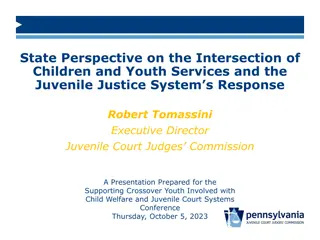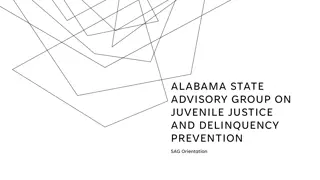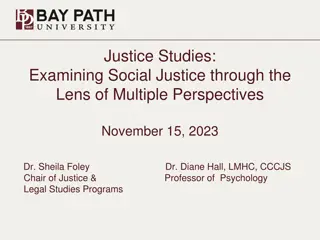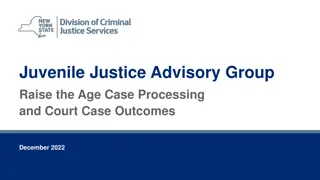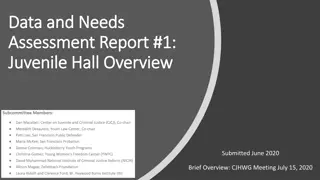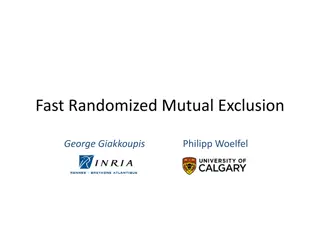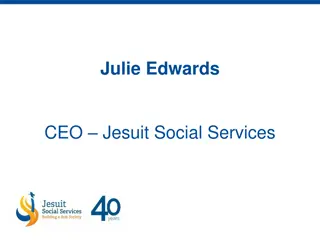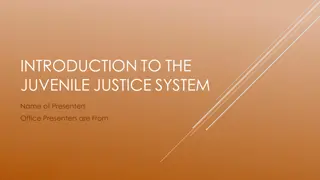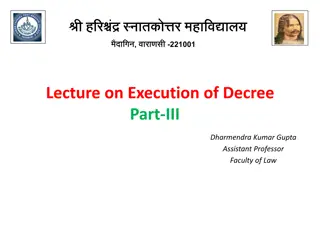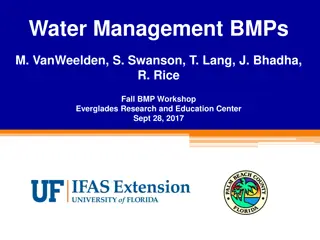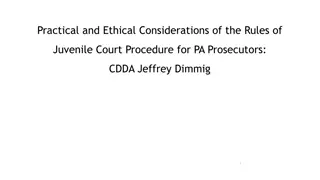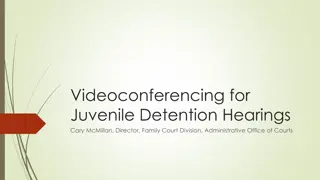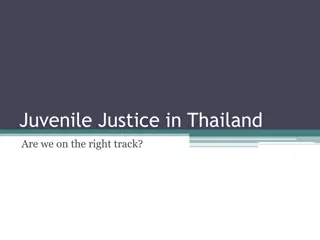Addressing Secure Detention and Juvenile Justice: ICJ Rules and OJJDP Exclusion
This training session focuses on how the ICJ Rules address secure detention for juveniles and the enforcement of the OJJDP exclusion within state judiciary. Explore topics such as serving juveniles while protecting communities, the JJDPA, deinstitutionalization of status offenders, and voluntary/non-voluntary returns under the ICJ Rules. The session also covers the release of runaways, the OJJDP exclusion policy, and survey results regarding resistance faced by state Compact Offices in applying the OJJDP exclusion in ICJ cases.
Download Presentation

Please find below an Image/Link to download the presentation.
The content on the website is provided AS IS for your information and personal use only. It may not be sold, licensed, or shared on other websites without obtaining consent from the author.If you encounter any issues during the download, it is possible that the publisher has removed the file from their server.
You are allowed to download the files provided on this website for personal or commercial use, subject to the condition that they are used lawfully. All files are the property of their respective owners.
The content on the website is provided AS IS for your information and personal use only. It may not be sold, licensed, or shared on other websites without obtaining consent from the author.
E N D
Presentation Transcript
Session I: ICJ and Secure Detention Presenters: Kari Rumbaugh (NE) Anne Connor (NV) Dale Dodd (NM) Maria Genca (CT) Rick Masters
Objective This training will look at how ICJ Rules address secure detention and how to enforce the OJJDP exclusion with state judiciary. 2 Serving Juveniles While Protecting Communities
Juvenile Justice and Delinquency Prevention Act (JJDPA) and the Deinstitutionalization of Status Offenders (DSO) Serving Juveniles While Protecting Communities 3
ICJ Rules Serving Juveniles While Protecting Communities 4
Voluntary & Non-Voluntary Returns ICJ Rules allow for the secure detention of non- delinquent runaways, accused status offenders, escapees, absconders and accused delinquents. Juveniles may be held for a maximum of 90 calendar days. Serving Juveniles While Protecting Communities 5
Voluntary & Non-Voluntary Returns Rule 6-101: Release of Runaways to Parent or Legal Guardian Runaways held over 24 hours do not have to be held in secure detention Runaways endangering themselves or others held beyond 24 hours shall be held in secure facilities Secure facility vs. secure detention Serving Juveniles While Protecting Communities 6
OJJDP Exclusion Juveniles held pursuant to the ICJ are excluded from the deinstitutionalization of status offenders requirements. Serving Juveniles While Protecting Communities 7
Survey Results Does your state Compact Office face resistance from courts for applying the OJJDP Exclusion in ICJ Cases? NO 49.02% 50.98% YES Serving Juveniles While Protecting Communities 8
Non-delinquent Runaways and Status Offenders Serving Juveniles While Protecting Communities 9
Survey Results Does your state have statues/regulations etc. prohibiting detention of runaways? Does your state have statutes/regulations etc. in place prohibiting detention of status offenders? NO 43.14% NO 31.37% 56.86% YES 68.63% YES Serving Juveniles While Protecting Communities 10
How do you detain a status offender when state laws do not permit detainment of youth in locked facilities? Serving Juveniles While Protecting Communities 11
How do you approach the courts when the OJJDP exclusion is not enough to override policies on the secure detention of non-delinquent juveniles? Serving Juveniles While Protecting Communities 12
Where do states hold victims of human trafficking? Serving Juveniles While Protecting Communities 13
Accused and Adjudicated Delinquent Juveniles Serving Juveniles While Protecting Communities 14
Survey Results Does your state permit juveniles who are adjudicated delinquents to be detained for all or part of the sentence or disposition? NO 9.8% 90.2% YES Serving Juveniles While Protecting Communities 15
How do you handle home/demanding states or legal guardians reluctant to make arrangements for a juvenile who is not securely detained? Serving Juveniles While Protecting Communities 16
How do you detain a juvenile listed as a Missing Person in NCIC? Serving Juveniles While Protecting Communities 17
Scenarios Serving Juveniles While Protecting Communities 18
Scenario Two delinquent runaways in State A are absconders from State B No warrant Adult court on new charges in State A Bond set; released from detention center Why weren t the juveniles returned with ICJ Form III? Serving Juveniles While Protecting Communities 19
Scenario Juvenile located by law enforcement in State A Found in NCIC as a missing person in State B Placed in runaway shelter Compact Office requested secure detention State A s detention center refused Juvenile runs away from shelter Sexually assaulted on streets What is the liability for States A & B to be sued by parents of juvenile for refusal to follow ICJ Rules? Serving Juveniles While Protecting Communities 20
Scenario Juvenile runaway located in State A reported runaway status and on probation in State B No warrant State B does not want juvenile to return Juvenile held in State A detention center Juvenile released to mother living in State A Was the juvenile correctly held in the detention center? Serving Juveniles While Protecting Communities 21
Scenario Juvenile picked up by law enforcement in State A Juvenile discloses runaway status from State B Juvenile not found in NCIC What are State A and State B Compact Offices responsible for? Serving Juveniles While Protecting Communities 22
Scenario Nebraska Secure vs. Staff Secure Non-violent runaways Detention center decision? Staff decision? Serving Juveniles While Protecting Communities 23
Opposition : SOS Project Coalition for Juvenile Justice Preventing court involvement and incarceration of status offenders and non-delinquent juveniles. Serving Juveniles While Protecting Communities 24
White Paper Temporary Secure Detention of Non-Adjudicated Juvenile Runaways October 2013 Serving Juveniles While Protecting Communities 25
Questions? 26




